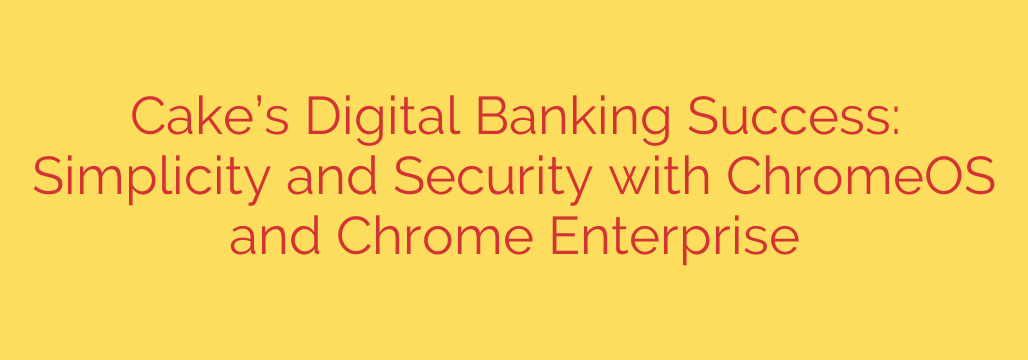
The Blueprint for Modern Banking: Securing Operations with a Cloud-Native Approach
In today’s fast-paced digital finance landscape, security and efficiency are not just advantages—they are absolute necessities. Financial institutions, from nimble fintech startups to established banks, face a relentless barrage of cyber threats while simultaneously needing to scale operations quickly and manage a growing, often remote, workforce. Traditional IT infrastructure, with its complex management and vulnerability to malware, is no longer sufficient for the task.
The solution lies in a fundamental shift towards a cloud-native operating system. By embracing a secure, simple, and scalable platform, financial organizations can build a resilient foundation for growth, protect sensitive customer data, and empower their teams to work productively from anywhere.
The Core Challenge: Overcoming Legacy IT Complexity
For many in the financial sector, the standard operating environment presents significant hurdles. Managing fleets of devices running traditional operating systems is a resource-intensive task. IT teams are burdened with:
- Complex Device Setup: Manually configuring each new employee’s computer is time-consuming and prone to error.
- Constant Security Patching: The responsibility for security updates often falls on individual employees, who may delay or ignore them, opening up critical vulnerabilities.
- High Risk of Malware: A single employee downloading a malicious file can compromise an entire network, leading to devastating ransomware attacks and data breaches.
- High Total Cost of Ownership (TCO): The combined expense of hardware, software licenses, intensive IT support, and security incident response creates a significant financial drain.
These challenges demand a new way of thinking—one that prioritizes security and simplicity from the ground up.
A New Paradigm: Security and Simplicity with ChromeOS
Adopting a cloud-first ecosystem built on ChromeOS and managed with Chrome Enterprise Upgrade offers a powerful solution to these legacy problems. This approach is designed for the modern workplace, delivering robust security and streamlined management that allows financial institutions to focus on innovation rather than IT maintenance.
1. Streamlined Deployment and Effortless Management
One of the most immediate benefits is the radical simplification of device deployment. With zero-touch enrollment, new Chromebooks can be shipped directly to employees, whether they are in the office or working remotely. The moment the user connects to the internet and signs in, the device automatically configures itself with the correct company policies, applications, and security settings.
This process completely eliminates the need for manual IT intervention, drastically reducing onboarding time from hours to mere minutes. IT administrators can manage their entire fleet of devices from a single, cloud-based Google Admin console, pushing updates, setting policies, and even disabling a lost or stolen device with a few clicks.
2. A Fortress by Design: Multi-Layered Security
For any financial institution, security is non-negotiable. ChromeOS is engineered with a security-first architecture that proactively defends against threats.
- Sandboxing: Every application and web page runs in its own isolated environment, or “sandbox.” This means that even if a user visits a malicious site, the threat is contained and cannot infect other parts of the system. This virtually eliminates the threat of traditional viruses and malware.
- Verified Boot: Each time a Chromebook starts up, it performs a self-check to detect any tampering or corruption of the system files. If any issues are found, it automatically repairs itself, often reverting to a known good version of the OS.
- Automatic, Seamless Updates: Security patches and feature updates are pushed automatically in the background without interrupting the user. This ensures that every device is always running the latest, most secure version of the OS, closing vulnerabilities before they can be exploited.
By integrating these features at its core, this cloud-native system significantly reduces the attack surface that cybercriminals target, providing peace of mind for both the institution and its customers.
3. Enhancing Productivity and Scalability
A secure and simple system fosters a more productive workforce. Chromebooks are known for their lightning-fast boot times (under 10 seconds) and long battery life, allowing employees to start working instantly and stay productive throughout the day. The intuitive, web-first interface requires minimal training, ensuring employees can access their cloud-based tools and applications seamlessly.
As a company grows, this model scales effortlessly. Adding a new team member is as simple as ordering a new device and assigning a license—the system handles the rest. This agility is crucial for dynamic organizations that need to adapt quickly to market demands.
Actionable Security Tips for Your Organization
Transitioning to a more secure, cloud-native environment is an achievable goal. Here are key steps to consider:
- Audit Your Current Endpoint Security: Identify the primary pain points in your existing device management. Where are you spending the most time? What are your biggest security risks?
- Embrace a Zero-Trust Philosophy: Operate on the principle of “never trust, always verify.” A secure-by-design OS is a critical component of a zero-trust framework, ensuring every device connecting to your network is secure by default.
- Prioritize Cloud-Based Applications: Move critical workflows to secure, browser-based applications (SaaS). This reduces reliance on locally installed software, which is a common vector for malware.
- Run a Pilot Program: Start by deploying Chromebooks to a specific department or team. This allows you to measure the improvements in productivity, security posture, and IT workload before a full-scale rollout.
By rethinking the approach to endpoint security and management, financial institutions can build a more resilient, efficient, and future-proof operation. The move to a cloud-native OS isn’t just an IT upgrade; it’s a strategic business decision that fortifies defenses, empowers employees, and paves the way for sustainable growth.
Source: https://cloud.google.com/blog/products/chrome-enterprise/how-cake-vietnams-leading-digital-bank-found-the-right-mix-of-simplicity-and-security-with-chromeos-and-chrome-enterprise/








